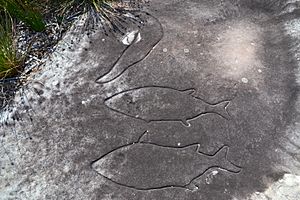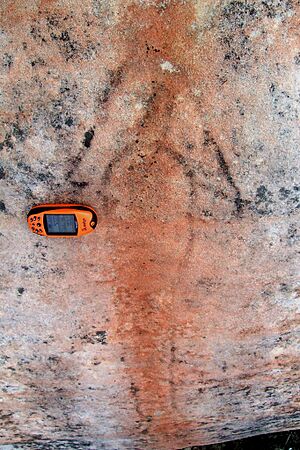Sydney rock engravings facts for kids
Sydney rock engravings, also called Sydney rock art, are special drawings made by Aboriginal Australians on sandstone rocks around Sydney, New South Wales, Australia. These drawings show people, animals, and symbols. Thousands of these amazing artworks exist in the Sydney area. Many locations are kept secret to protect them from damage and because they are still considered sacred by Indigenous Australians.
Sydney has about 1,500 pieces of Aboriginal art. More than half of these are rock engravings. There are also about 1,500 caves or shelters with cultural items. These engravings are similar to rock carvings found in other parts of the world, but they have their own unique style. Some of these artworks are around 5,000 years old, and some might even be as old as 7,000 years! You can mostly find Sydney rock art in areas like Ku-ring-gai Council, Sydney Harbour, and the Blue Mountains.
Contents
Who Made the Engravings and When?

These engravings were created by the Aboriginal people who have lived in the Sydney region for a very long time. People have lived in the Sydney area for at least 30,000 years. Some stone tools found in Western Sydney suggest people might have been there even earlier, possibly 45,000 to 50,000 years ago.
It's tricky to figure out the exact age of these engravings. Scientists use indirect ways to guess their age. The style of Sydney engravings is called "simple figurative". This style is thought to be from around 5,000 to 6,000 years ago. However, some engravings show European sailing ships, meaning those particular ones can't be more than about 200 years old. It's likely that the freshest-looking engravings are newer, while the most worn ones are older. But it's complicated because the Aboriginal people sometimes re-carved the lines during ceremonies.
Some engravings seem to show animals like thylacines. These animals have been extinct in the Sydney area for thousands of years. This could mean those specific engravings are very old. Rock art in other parts of Australia, like Kakadu National Park, does show extinct animals and is tens of thousands of years old. However, there isn't strong proof yet to confirm these very old dates for Sydney rock art.
How Were the Engravings Made?
The grooves in the rock show that the engravings were made in a few steps:
- First, a rough outline was probably scratched onto the rock surface.
- Then, small holes were drilled along this line. They used a pointed stone or shell for this. The Sydney Basin sandstone is soft enough for this method.
- Finally, the holes were connected by rubbing a sharp stone along the line.
This process created a U-shaped groove. These grooves are usually about 2 centimetres deep and 2 centimetres wide. It's easy to tell them apart from natural grooves in the sandstone, which are usually V-shaped. They also look different from modern grooves made with metal tools or bulldozers.
The Aboriginal people often "re-grooved" the lines during ceremonies. This helped keep the engravings clear and fresh. It also makes it harder for scientists to figure out their exact age.
What Was Their Purpose?
While we don't know for sure why every engraving was made, we can make educated guesses. We compare them to what we know about other Aboriginal groups.
Some sites might have been "increase sites." Here, ceremonies would be held to help increase food sources like kangaroos or fish. Most sites that show animals are thought to be this type.
Other sites might have been used for initiation ceremonies. These ceremonies helped young boys become men. In other parts of Australia, we know that initiation often involved a special path. So, lines of footprints, called mundoes, might show initiation sites.
Some sites show "Culture Heroes" or "Ancestral Beings." These are important figures in Aboriginal stories. For example, Baiame often has a striped head-dress and body. Daramulum has a large club foot and might have been part-emu.
Some sites also seem to show Aboriginal Astronomy. The patterns on the rock might look like the Milky Way. These could have been used as a guide to the stars. It's important to remember that a single site could have been used for many different purposes.
What Do the Engravings Show?

Aboriginal rock engraving sites usually show sacred spiritual beings and mythical ancestral heroes. They also feature many local animals, fish, and footprints. Around these engraving sites, you can find other important places. These include burial sites, caves, marriage areas, men’s areas, women’s areas, birthing areas, midden sites (ancient rubbish dumps), stone arrangements, and places where tools were made.
Les McLeod, a local Indigenous guide, explained that many Aboriginal people believe they were created from animals. This is why you see engravings of wallabies, fish, and emus. Sydney sandstone is easy to engrave, but it also fades easily. The Guringai people would visit the sites a few times a year to re-engrave them.
In some small caves near the water, there are hand stencils made with ochre. These were made by Guringai men and sometimes by younger people. The stencils were a way to let other clan members know that the cave was a safe place. Rock paintings of fish near the water line told others that fish could be found there. Most of the etched designs are just outlines. Only the culture heroes are usually filled in with pecked lines of dots.
Art Styles and Colors
Rock shelters with art often have stencil art or charcoal drawings. Stencils were made by mixing ochre into a wet paste and spraying it over an object onto the wall. Other artworks include ochre paintings, charcoal drawings, and etchings. Rock paintings usually show humans, kangaroos, emus, echidnas, grid patterns, animal tracks, boomerangs, axes, and hand stencils.
Black is the most common color used in Sydney rock art, making up about 46% of the painted art. White is next (34.6%), followed by red (16.6%) and yellow (2.8%). There are also many grinding grooves in the Sydney area. These are places where tools were sharpened. Burial sites are also found throughout the Sydney region.
Sydney rock engravings often feature fish, animals, humans, wooden tools, and mythological beings. Stone quarries were places where Aboriginal people gathered different types of stone to make tools, ceremonial items, and sacred objects. Many fine stone tools found locally were traded from other areas. Dug wells in the Sydney region were used by local tribes to sharpen tools and as a source of fresh drinking water.
What Animals and Objects Are Most Common?
Scientists studied 7,804 designs from 717 engraving sites. They found that animal tracks were the most common. After that, marine animals (sea creatures) and land animals were very popular. Human-like figures and cultural items were also common.
| What's Drawn | How Often (in %) | |
|---|---|---|
| 1 | Human Footprints | 17.4 |
| 2 | Fish | 11.6 |
| 3 | Unidentified Closed Shapes | 9.1 |
| 4 | Bird Tracks | 7.0 |
| 5 | Macropod (like kangaroos/wallabies) | 7.0 |
| 6 | Unidentified Open Shapes | 6.1 |
| 7 | Man | 5.4 |
| 8 | Other Land Animal | 4.0 |
| 9 | Boomerang | 3.9 |
| 10 | Circle | 3.9 |
| 11 | Shield | 3.0 |
| 12 | Other Material Object | 2.8 |
| 13 | Eel | 2.3 |
| 14 | Anthropomorph (human-like figure) | 2.3 |
| 15 | Other Bird | 2.1 |
| 16 | Other Marine Animal | 2.0 |
| 17 | Whale | 1.3 |
| 18 | Woman | 1.0 |
| 19 | Profile Anthropomorph | 0.9 |
| 20 | Emu | 0.9 |
| 21 | Complex-Non-Figurative | 0.9 |
| 22 | Snake | 0.7 |
| 23 | Axe | 0.6 |
| 24 | Culture Hero | 0.5 |
| 25 | Contact Motif | 0.5 |
| 26 | Kangaroo Track | 2.4 |
| 27 | Hand | 0.2 |
Where Can You Find These Sites?
There are about 2,000 rock engraving sites. They are usually found on high, smooth, flat rock surfaces. More than half of these sites (55.9%) are on the tops of ridges. Hillside locations are also common (41.2%), while valley bottoms are rare (2.8%). Most engraving sites are about 650 meters from drinking water. The furthest is about 3 km, and the closest is just 2 meters (near rock wells or creeks).
Here are some places in Sydney and the Blue Mountains where you can find rock art:
- Sydney
- Bantry Bay in Garigal National Park, Sydney Harbour (a large site with many engravings of animals, people, symbols, and a whale)
- North Bondi Rock Carvings in Bondi Beach (shows humans, sharks, fish, whales, and a turtle)
- Allambie Heights (features a whale and many smaller engravings)
- Heathcote National Park, south of Sydney. Various sites are known, including a shield tree and charcoal drawings.
- Grotto Point at Dobroyd Head in the Northern Suburbs (a well-kept site with many engravings)
- Balls Head Reserve in Port Jackson (art sites, middens, and a large carving of a sea creature)
- Tamarama (a large engraving of a shark and fish)
- Berowra Waters (has a complex carving on a vertical rock)
- Terrey Hills (a lone emu on a rock ledge)
- Ku-ring-gai Chase National Park, north of Sydney (many sites, especially along the Basin Track, Echidna Track, Cowan Track, and Red Hand Track)
- Muogamarra Nature Reserve, Hawkesbury River area (numerous sites including carvings and grinding grooves)
- Blue Mountains
- Faulconbridge (three emus, some mundoes or footprints, and axe-grinding grooves)
- Lawson (a single kangaroo on a rock)
- Kings Tableland Aboriginal Site, Wentworth Falls (a rocky hill with large grinding grooves, carved images of wallabies, emu tracks, and an occupation cave)
- Red Hands Cave, Blue Mountains National Park, outside Glenbrook (a large collection of hand stencils)
- Wollemi National Park, north of the Blue Mountains (many Aboriginal sites, including Eagles Reach Cave, found in 1995)
Gallery
-
A rock engraving believed to be a turtle at Bondi Beach
-
Petroglyph of a shark in North Bondi
-
Engraving of a human figure in North Bondi
See also
 In Spanish: Grabados rupestres de Sídney para niños
In Spanish: Grabados rupestres de Sídney para niños
- Visual arts of Australia
- Aboriginal sites of New South Wales
- List of Stone Age art












